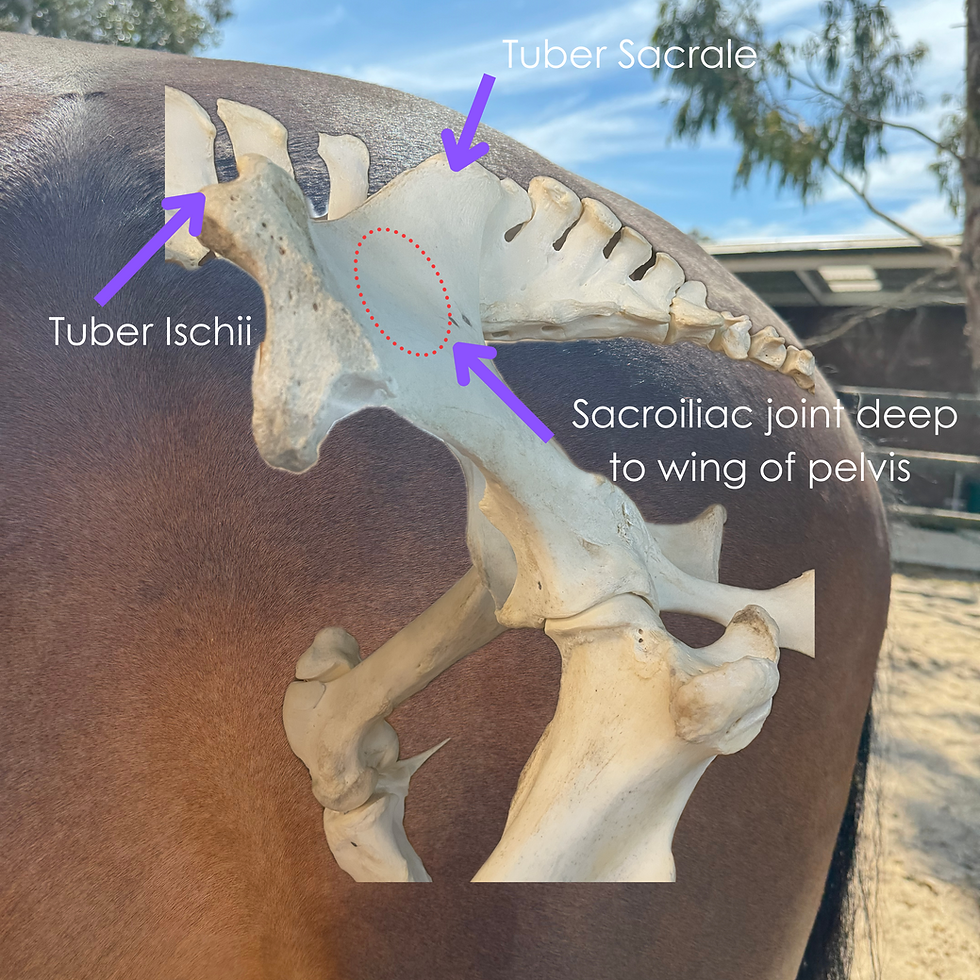Imaging of the Stifle: Practical Approaches for Accurate Diagnosis
- Anushka von Oppen

- Feb 20
- 4 min read
Updated: Jul 11

The equine stifle is a complex joint, it is the largest joint in the horse and plays a crucial role in locomotion and performance.
Given its intricate anatomy, accurate imaging is essential for diagnosing injuries and guiding treatment plans.
While advanced imaging modalities such as computed tomography (CT) can offer detailed cross-sectional imaging, accessibility remains a challenge in many regions, including here in Victoria. Instead, ultrasonography has become an invaluable tool in equine veterinary practice, providing detailed insights into the joint's soft tissue and cartilage health.
Anatomy Recap

The range of motion of the stifle joint is primarily flexion and extension, which is key in providing propulsion and weight-bearing.
This range of motion is made possible through the coordinated function of multiple structures, in particular the neuromuscular co-ordination it takes to disengage the patella from the femur.
The Stifle is made up of:
- The Femur, Tibia, and Patella: the joints are divided up into 3 different compartements; medial & lateral femorotibial and the femoropatellar joint.
- Cruciate Ligaments: The cranial and caudal cruciate ligaments provide intrinsic stability by preventing excessive forward and backward movement of the tibia relative to the femur.
- Menisci: Acting as shock absorbers, the medial and lateral menisci cushion impact forces and ensure smooth articulation between the femur and tibia.
- Patellar Ligaments: The medial, middle, and lateral patellar ligaments work in conjunction with the quadriceps muscle to support patellar movement and enable the locking mechanism crucial for weight-bearing.
- Collateral Ligaments: The medial and lateral collateral ligaments restrict excessive lateral and medial movement, enhancing joint stability.
This highly coordinated system allows for efficient movement while maintaining joint integrity. Any compromise in these stabilising structures (injury or degeneration) can lead to instability, discomfort, and impaired performance.
Diagnostic Imaging Modalities for the Equine Stifle
Radiography
Radiography is often the first imaging modality used in stifle evaluations. It provides an excellent overview of bony structures, allowing us to detect arthritic changes, osteochondral lesions, subchondral bone defects, fractures and remodelling associated with ligamentous insertions. However, radiographs have limitations in assessing soft tissue structures, which are integral to stifle function and integrity.
Xrays of a normal stifle joint
Some arthitic changes that we can see in the stifle. Image left and centre: the arrows highlight a large subchondral bone cyst.
Ultrasonography
Ultrasonography is a highly valuable tool to evaluate key soft tissues, cartilage and the subchondral bone of the stifle joint. With specific techniques we can evaluate the structural integrity of the:
- Synovial Structures and Cartilage: Joint effusion, synovial thickening, and cartilage integrity and defects can be visualised, helping to guide both diagnosis and treatment strategies.
- Menisci: Detecting meniscal tears and degeneration is crucial, especially in sport horses presenting with subtle or chronic lameness.
- Patellar Ligaments: There are 3 ligaments - middle, medial, and lateral patellar ligaments which not uncommonly can show signs of inflammation (desmitis).
- Subchondral Bone health: Ultrasonography can often highlight subtle flattening or defects in the subchondral bone surface with more sensitivity than with x-ray.
Some normal images of the particularly the medial stifle joint.
Some abnormal images of the medial stifle joint: Left image - red arrow highlights a large osteophyte (bone remodelling of the medial femur), the medial joint is enlarged compared to the normal image with synovial thickening (yellow arrow); Middle image - thickening, fibrillar disruption (tear) and bone remodelling in regards to the insertion of the medial meniscus; Right image - red arrows highlight a subchondral bone defect (small cyst).
Scintigraphy
Scintigraphy (nuclear medicine bone scanning) is a valuable diagnostic tool when other imaging modalities do not clearly localize the source of pain or lameness. This technique is particularly useful in detecting stress-related bone injuries, subchondral bone disease, and areas of active bone remodeling that may not be apparent on x-rays. By injecting a radiopharmaceutical tracer that accumulates in areas of increased metabolic activity, scintigraphy provides functional imaging of the stifle and can help identify pathology that requires further investigation with radiographs, ultrasound, or advanced imaging techniques.
Magnetic Resonance Imaging (MRI) and Computed Tomography (CT)
While MRI offers exceptional soft tissue contrast, it is primarily limited to distal limb imaging in most equine facilities. CT, on the other hand, provides high-resolution bony detail but requires general anesthesia for this region of the body and its availability remains limited here in Victoria. These factors make ultrasonography the most practical and frequently used tool for equine stifle evaluation.
Clinical Relevance: Why Stifle Imaging Matters
Early and accurate diagnosis of stifle injuries is critical for managing lameness and optimising a horse’s performance. Ultrasonography enables us to identify subtle pathology that may be missed on radiographs, facilitating targeted treatment approaches such as regenerative therapies, intra-articular injections, or rehabilitation programs.
While CT and MRI can provide additional insights when available, x-ray and ultrasonography remain indispensable tools. Effective imaging allows us to assess stifle health efficiently and guide evidence-based treatment plans, ensuring the best possible outcomes for equine athletes and pleasure horses alike.
Concerned about lameness in your horse? Get in touch here to consult with a trusted horse vet in Melbourne






























Comments